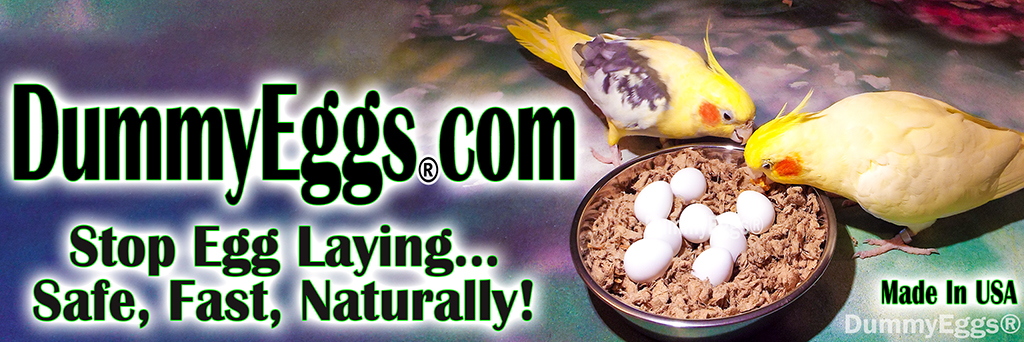


It all started back in 2006, when my husband Kirk and I found ourselves in an unwanted hatching egg situation. Our bonded pair of Cockatiels laid fertile eggs, but we weren't in a position to care for any additional chicks. We scoured the internet and found only a few scattered posts about using fake eggs as replacements. But finding plastic eggs? That was a different story altogether!
Fast forward to 2023, and DummyEggs®.com has become a lifesaver for pet bird owners worldwide! Avian Veterinarians regularly recommend us to clients because they know we've got the perfect solution for when their hens start laying eggs. And let me tell you, the worst thing you can do is just throw those eggs away! That's a surefire way to drain your bird's body of vital calcium and nutrients, leading to life-threatening conditions like egg binding and calcium deficiency.
Now, here's where DummyEggs. com comes in. We've got a wide range of plastic eggs that simulate a full clutch of eggs. Your bird can sit on them until she loses interest, feeling fulfilled, and without any adverse health effects. We believe in giving your birds what they really want... a full clutch of eggs that signal to them to stop laying more. Our simple and healthy solution has worked like magic for countless pet owners, and we're confident it'll work for you too!
Sure, our small-batch, specialty, and niche production methods might cost a little more, but we're committed to providing you and your feathered friends with the very best. Our philosophy is all about keeping your birds healthy and happy, and we wouldn't have it any other way
Melanie & Kirk
DummyEggs.com
info@dummyeggs.com
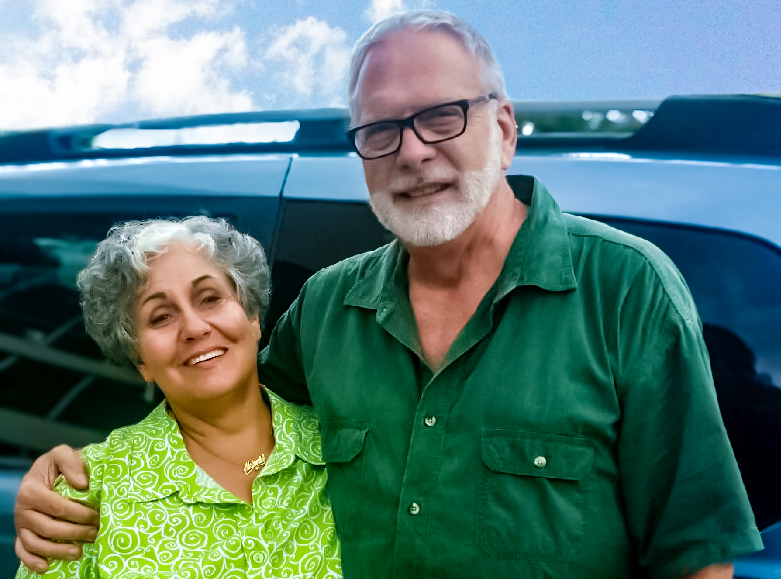
Melanie & Kirk
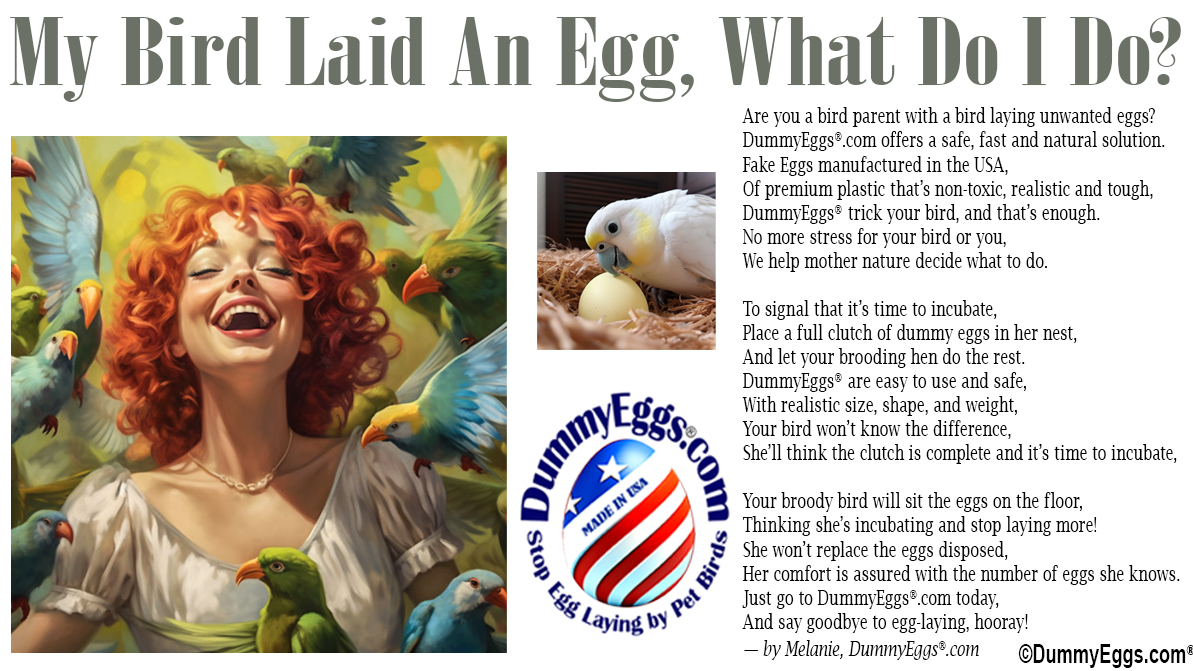
Are you a bird parent with a bird laying unwanted eggs?
DummyEggs®.com offers a safe, fast and natural solution.
Fake Eggs manufactured in the USA,
Of premium plastic that’s non-toxic, realistic and tough,
DummyEggs® trick your bird, and that’s enough.
No more stress for your bird or you,
We help mother nature decide what to do.
To signal that it’s time to incubate,
Place a full clutch of dummy eggs in her nest,
And let your brooding hen do the rest.
DummyEggs® are easy to use and safe,
With realistic size, shape, and weight,
Your bird won’t know the difference,
She’ll think the clutch is complete and it’s time to incubate.
Your broody bird will sit the eggs on the floor,
Thinking she’s incubating and stop laying more!
She won’t replace the eggs disposed,
Her comfort is assured with the number of eggs she knows... say goodbye to egg-laying, hooray!
— by Melanie, DummyEggs®.com
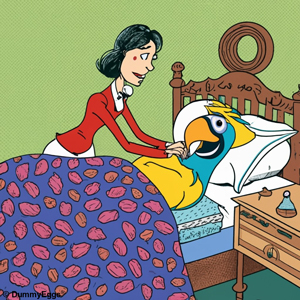
Anthropomorphism, the attribution of human characteristics, emotions, and intentions to animals, is a common phenomenon among pet owners, particularly when it comes to birds. When bird owners anthropomorphize their pets, they may project their own beliefs and desires onto their avian companions. This can be especially evident in the context of whether or not birds "need" to breed. Here are some ways in which this projection can occur:
Bird owners often want their pets to be happy and fulfilled, and they may assume that breeding is a source of joy for their birds. They might project their own emotions onto their birds, believing that breeding is essential for their emotional well-being. However, birds do not necessarily have the same emotional needs or desires as humans.
Owners may perceive breeding as a way for their birds to engage in social activities or to bond with a mate. While social interaction is essential for birds, this can be misinterpreted as a need to breed. In reality, birds can form strong social bonds without necessarily breeding.
Some bird owners may believe that their female birds have a strong maternal instinct and need to experience motherhood. This belief can lead to the assumption that denying them the chance to breed is somehow depriving them of an essential experience. However, not all female birds have a strong maternal instinct, and not all birds should be bred.
Bird owners might project their own desires for personal fulfillment or the thrill of raising chicks onto their pets. They may assume that breeding is a natural and necessary part of their bird's life without considering the potential drawbacks or challenges involved.
Some owners believe that breeding can be a source of stress relief or provide a sense of purpose for their birds. This projection may lead them to think that breeding is essential for reducing stress or anxiety in their pets.
It's important for bird owners to remember that birds have their own unique needs, behaviors, and instincts. While breeding is a natural behavior for many bird species, it doesn't necessarily translate to an essential experience or need for every individual bird. Each bird is an individual, and decisions regarding breeding should be made with careful consideration of their well-being, the resources available, and the potential consequences.
Responsible pet ownership involves understanding and respecting the natural behaviors of birds while also prioritizing their health and happiness. This often means making informed decisions that may not align with human projections and anthropomorphic beliefs.
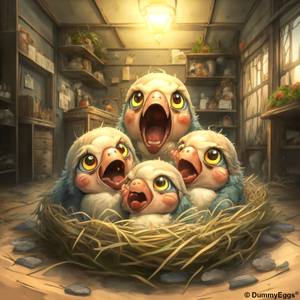
Raising baby birds is a rewarding and challenging endeavor. Whether you're an avian enthusiast or a pet owner, understanding the various aspects of bird rearing is essential for the well-being of these feathered companions. In this article, we will explore important considerations before taking on the responsibility of raising baby birds, from understanding incubation to hand-rearing and finding suitable homes for the chicks.
Before embarking on the journey of raising baby birds, it's crucial to comprehend the basics of egg incubation. This includes understanding the incubation periods for different bird species, factors influencing successful incubation, and the role of temperature and egg quality in the process.
Hand-rearing baby birds is a significant component of their early development. This process not only involves feeding but also gentle handling, interaction, and exposure to various stimuli. Well-socialized pet birds, often hand-raised by dedicated breeders or caregivers, tend to form more affectionate and trusting relationships with humans. However, it's essential to recognize that the ease in rehoming baby birds is often dependent on their personalities and socialization. Some birds may readily adapt to new homes and caregivers, while others may find the transition more challenging.
Some bird parents may ignore their hatchlings, or, for various reasons, the chicks may require extra care. Hand feeding hatchlings, a delicate and time-consuming process, is crucial for their nutrition and growth. The socialization that comes with hand-raising helps baby birds’ bond with humans, making them more comfortable with human companionship.
A critical aspect of raising baby birds is the responsibility of finding suitable homes for the chicks. Understanding the growing issue of homeless birds and parrots in shelters, like the problem of homeless dogs, highlights the importance of responsible breeding practices and the necessity to address overpopulation in avian species.
Raising baby birds is a labor of love and commitment. It's essential to consider all aspects of their care, from incubation to hand-rearing and finding appropriate homes for the chicks. By understanding these key considerations, potential bird parents can ensure the welfare and happiness of their feathered companions while contributing to the responsible stewardship of avian species.

The idea of projecting human desires onto pet birds, particularly the notion of providing a mate for them, is an interesting aspect of avian care. Many bird owners may anthropomorphize their pets, attributing human emotions and needs to them. The desire to see their birds with a mate could stem from a well-intentioned effort to fulfill what is perceived as a natural instinct or need for companionship in the avian world.
However, it's crucial for bird owners to approach the idea of providing a mate with careful consideration. While companionship is important for birds, it doesn't always have to come in the form of a mate. In the wild, birds form complex social structures, and having a mate is just one aspect of their social life. Additionally, not all birds necessarily seek out mates, and some may prefer to live solitary lives.
There are potential drawbacks and challenges to introducing a mate to a pet bird's environment. The responsibilities of breeding, including egg-laying, incubation, and caring for chicks, can be demanding and may require specialized knowledge and resources. Moreover, introducing a new bird into an established household can lead to territorial issues, aggression, or other behavioral challenges.
In some cases, providing companionship through interaction with the owner, enrichment activities, and a stimulating environment can be equally fulfilling for pet birds. Understanding the specific needs and behaviors of the bird species in question is essential to making informed decisions about their social environment.
Determining the sex of a potential mate for pet birds can indeed pose challenges for bird owners. In many bird species, visual cues to distinguish between male and female individuals may not be easily apparent, especially to those who are not well-versed in avian anatomy or behavioral differences.
Here are some additional points on the difficulties of determining the right sex of a potential mate:
Some bird species are sexually dimorphic, meaning there are visible differences between males and females in terms of size, coloration, or physical features. However, many species are monomorphic, where males and females look nearly identical. This can make it particularly challenging for bird owners to determine the sex without resorting to more invasive methods.
In some cases, behavioral cues may provide hints about a bird's gender. Males of certain species may be more vocal or exhibit specific courtship behaviors. However, relying solely on behavior can be misleading, as individual personalities and environmental factors can also influence behavior.
To accurately determine the sex of a bird, especially in monomorphic species, DNA testing is a reliable method. This typically involves a blood test or plucking a few feathers for analysis. While effective, it may not be a practical or immediate solution for those seeking a mate for their pet birds.
Seeking the expertise of an avian veterinarian or a knowledgeable bird breeder can be invaluable in identifying the sex of a potential mate. These professionals often have experience in sexing birds and can provide guidance based on their expertise.
The age of the bird can also impact the accuracy of sex determination. In some species, males and females may not exhibit distinct characteristics until they reach sexual maturity, adding an additional layer of complexity.
Different bird species present unique challenges in sex determination. For example, some parrot species may require a closer examination of the cere (the fleshy area above the beak), while for certain songbirds, plumage coloration may be the key indicator.
Accurately determining the sex of a potential mate for pet birds often requires a combination of methods, and it's important for bird owners to be aware of the specific characteristics of their bird species. Seeking professional advice and using methods such as DNA testing can contribute to a more informed decision when introducing a mate to a pet bird.
It's crucial for bird owners to research and understand the natural behaviors of their specific bird species and to consult with avian experts or veterinarians when considering introducing a mate. The goal is to ensure the well-being and happiness of the pet birds while also recognizing and respecting their individual preferences and behaviors.
It is usually quite the surprise to parrot owners when their pet lays an egg, especially if they thought it was a male, or if it lives without a mate. Just like with production chickens laying eggs for consumption, any single bird will become reproductively active and can lay an unfertilized egg during its life in captivity. This article will focus on some key points to help explain the answers to the most frequently asked questions our clients have regarding this behavior including: why it happens, possible harmful complications, what to do when it happens, and how to prevent it from happening over and over again. Since reproductive disorders are common in pet birds, prevention and self-education are better than treatment, especially since some of these conditions can be life-threatening.
Why did my bird lay an egg when there is no mate present?
Egg laying can start whenever the species becomes sexually mature and can continue throughout the bird’s lifetime. Some birds will lay only once or twice in their lives, others will lay several times a year depending on the home environment and stimuli. In the wild many natural factors influence egg-laying and female parrots will generally not lay eggs unless they have a mate, a suitable nesting site, and the right environmental conditions and food availability. Their reproductive behaviors are often guided by food abundance and seasonal changes such as daylight hours. In captivity however, this behavior is often stimulated by other factors we may not even be aware we are providing. Some companion birds are more prolific and much more likely to lay eggs than other species based on genetic predisposition, such as budgies/parakeets, cockatiels, and Aratinga conures. Others can randomly lay due to the stimulants we provide in captivity.
Increased daylight hours: when birds think it is springtime, they are more likely to reproduce. When we wake them up early and keep them up with us at night, they don’t understand that our artificial light is not the sun and they can become reproductively active.
Constant sources of rich foods: when birds have ample foods high in fat and protein, their bodies become prepared to reproduce. In the wild, they reproduce when these kinds of natural resources are available based on the season. In captivity, when they are given these rich foods every day, their bodies are constantly ready and amped up for reproduction!
Inappropriate pair bonding with humans or inanimate objects: when birds perceive that there is a mate present, their bodies will think it’s time to make babies. An inappropriate mate is most often a chosen person in the home- often someone who allows the bird to physically be with them more than others, allows regurgitation behaviors, and is very affectionate. Occasionally this perceived mate could also be a mirror, a stuffed animal, or a favorite toy that the bird cuddles with, regurgitates on, or spends many hours a day with.
Excessive allopreeing: it is very rewarding to have a bird that enjoys being scratched, rubbed, and will reciprocate with straightening our hair or giving sweet nibbles. However, this behavior directly mimics what parrots and their mates do in the wild. Scratching under the wings, over the back, under the chin, and around the face/beak are all behaviors of bonded pairs of parrots in the wild. Doing this can encourage reproductive behavior such as egg laying.
Having access to a nesting sites: of course purchasing a nest for a bird is an obvious nesting site, but often people don’t realize that allowing a bird to forage/play in a cardboard box, offering the fuzzy tents sold in pet stores, allowing them to explore the kitchen cabinets, or burrowing in our clothes/bed linens are all nesting sites as well! In the wild, birds seek out small, dark spaces to make a nest such as a tree hollow or rock crevice. There are many of these “sites” in our homes and allowing birds to find them can induce them to lay eggs sometimes in these sites.

What are the potential complications?
1. Eggbinding: When birds lay eggs, they need to be in optimal condition in order to be able to produce the protein required, the calcium to shell the egg, and the energy to lay it properly. A poor quality diet for a bird that is not exposed to natural sunlight (to aid in calcium absorption) and that does not fly or have exercise may be deficient in many nutrients and vitamins and be in poor body conditon that is required for healthy egg laying. If the eggs are not shelled properly, they could be soft or lump or, they could have difficulty or even get stuck moving through the oviduct. If the bird does not have good muscle development or calcium stores, passing the egg may be difficult or impossible. These conditions can cause dystocia, or “egg binding” in birds. Birds that are having difficulty laying eggs may have the following symptoms:
Sitting on the bottom of the cage.
Difficulty breathing, which can appear like a tail bob, open beak panting, or a wide-legged stance with increased respiratory effort.
Blood coming from the vent (the opening where they poop from and where the egg passes). Straining or pushing excessively with no egg produced Pathologic bone fractures: When birds produce eggs, their bodies mobilize calcium from their bones, leaving them weak. Over time it is common to see fractured wings and/or leg bones occurring with no trauma, especially if they are not getting enough calcium and vitamin D3.
2. Egg yolk peritonitis: If there is reproductive disease, either from chronic egg laying or pathology in the oviduct, ovarian follicles can develop and instead of passing into the oviduct to be shelled normally, they fall into the body cavity. This can cause a serious inflammatory process that causes the coelom (abdomen) to fill with fluid. This can be very uncomfortable for birds, causing them to not be able to breathe well, become lethargic, and have a decreased appetite.
3. Hyperlipidemia: When birds are constantly laying eggs, there is often a high amount of circulating fats and proteins in the blood to facilitate egg production. This can cause dangerous thickening of the blood, with the potential to cause a bird to have a stroke (sometimes referred to as “yolk stroke”). These changes in the blood are often impossible to change with diet and exercise, and in many cases only hormone therapy or spaying will stop the condition.
4. Behavior problems: When birds are in a state of reproduction, they often have hormonal changes that make them irritable and uncomfortable. They can turn from a human-friendly buddy, to a vicious cage protective demon! Birds will often aggressively protect their eggs and/or nest area by lunging, hissing, biting, and screaming. They also will sometimes pull feathers from their body to make a nest (called a “brood patch”) in order to keep the eggs warm with their skin contact on them. But this behavior can preclude chronic feather picking behavior.
What do I do now that my bird laid an egg?
A few species of parrots are sexually dimorphic (you can tell the gender based on the physical appearance) and others are not, so many owners don’t know if they have a male or a female. (We strongly recommend bringing birds in for testing BEFORE a crisis occurs- we can easily determine the gender with a single drop of blood.) If you have a male and female, or are not sure, it is possible that the egg could be fertile, so as soon as you see an egg, you should remove it and replace it with a fake egg. Alternatively, you could boil or freeze the egg, but then return it to the nest. It is important to return some sort of egg to the nest because some birds will continue to lay eggs, trying to replace the lost ones. Once the eggs of a clutch are all laid and exchanged for fake or sterilized eggs, leave them with the birds, regardless if they are nesting them or not, for approximately 3 weeks. Then, remove them one at a time every other day until they are gone. This will hopefully give the female the time she needs to understand that those eggs are not viable and will not hatch. In most cases the birds will abandon the eggs after a period of time.
While she is laying/nesting on the eggs, be sure to communicate with your avian veterinarian regarding diet and possible nutritional supplementations. Each situation may be different based on history, species, diet, and other variables. Your pet’s doctor may recommend extra calcium, full spectrum light, protein, or other supplements during this time.
If you see any symptoms as described above, please give your avian veterinarian a call right away to schedule an appointment, or potentially bring your bird in for an emergency visit. These situations can be very dangerous and life threatening so you should not wait.
Tips to prevent laying eggs:
1. Move the bird’s cage to a different area of your home. Sometimes making birds feel a little uncomfortable will make their bodies recognize that it is not an ideal time to lay eggs.
2. Rearrange any perches, bowls, and toys in the cage. Again, making them feel just a bit like things are different or strange, less comfortable, they may not be as likely to lay eggs.
3. Remove any objects that your bird associates with “nesting”. These are usually cardboard boxes or fabric toys that your bird can “hide” in. Food bowls are also often used as make-shift nests and changing sizes and location may limit this behavior.
4. Remove any objects that your bird considers a “mate” such as mirrors, stuffed toys, special favorite perches, or even other birds. Sometimes birds may need a time-out from a mate or a perceived mate in order to prevent chronic egg laying.
5. Limit time with the bird’s human “mate”. Avoid bonding behaviors like grooming, kissing, and sharing food.
6. If your bird spends a lot of time out of its cage, discourage all nesting behavior. You may need to keep the bird caged for a while to prevent them from laying eggs in closets, behind/under furniture, or in cabinets.
7. Alter your bird’s light/dark schedule by covering the cage for at least 12 hours a night. Keeping them quiet and dark during these hours will create a sense that it is not springtime and not the time for making babies.
8. Keep your bird away from direct, bright sunlight during the day. It also may help to keep them away from windows and in a normally lit room.
Gratefully reproduced from
https://www.avianandexoticvets.com/
by Steve Hartman / The Parrot University
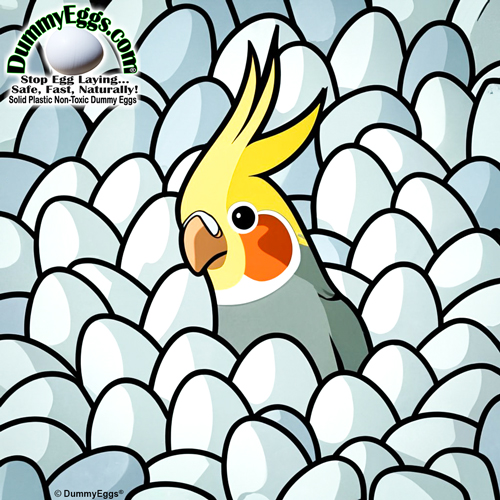
Why do cockatiels and some of the other smaller species of pet birds produce eggs when there is no male present?
Over the last few years, female cockatiels and other small pet bird species have accidentally been selectively bred for their ability to lay eggs without a mate present. We need to look back a few generations to find the source of the problem. Veterinarians, breeders and hobbyists have, in error, advised owners that a mate should be provided for these egg-laying pets. This is, in fact, the last thing that you want to do. Laying too many eggs can be a health hazard for a hen. Breeding her will increase the number of birds with this problem in the future.
The poultry industry has used this selective breeding technique in a positive way to significantly increase egg production in chickens. The original chicken was a small bird that laid an average of seven eggs each year. Today, with selective breeding and proper nutrition, the average chicken produces 252 eggs per year.
The hen that lays the most eggs and the most clutches of eggs in her life, produces the most babies. Super-producing hens are showing up at an increasing rate and developing into a major health problem for small companion birds. Professional and hobby breeders alike, utilize these abnormal hens to produce as many babies as possible for the pet trade.
Some of the female babies produced by these prolific hens will also have the ability to produce many eggs. If these females end up in a breeding situation, they will also produce a lot of babies and end up passing this trait on to more female babies. Over the last 20 years, some of these very prolific hens have caused these super-ovulating genes to be fixed into a significant percentage of the cockatiel and other small bird populations.
This situation is not limited to small birds. Because of the older age at which many of the larger parrots start to produce, they have not had as many generations of production. Smaller birds can begin reproducing at one year old while many of the larger parrots take five to ten years. This problem has developed in about 15 generations for the smaller birds. In about another 25 years, it will likely be as common in the larger parrots.
Problems that can arise A few of the birds that develop this problem will not suffer any undesirable effects. Unfortunately, this is not the situation for most of these birds. Many undesirable problems and situations can develop when a bird becomes a chronic egg layer. These problems include but are not limited to:
Aggression - the pet may become territorial and aggressively defend her territory.
Egg binding - the bird's system may not be able to provide the significant amount of resources necessary to produce so may eggs. Insufficient calcium reserves result in the oviduct not being able to provide the calcium lubricant for the egg to pass. The egg can become stuck and the bird will die without veterinary intervention.
Lack of pet appeal - because the birds is always sitting on eggs, she may not be an interactive companion.
Lack of exercise - a broody bird wants only to sit on eggs. This lack of exercise is OK for a normal period of incubation, but a chronic egg layer can experience several inactive months each year.
Calcium depletion and many resulting health problems - Egg production requires significant amounts of calcium, protein and fat. Inactivity, loss of appetite, and a significant loss of calcium can result in too many short and long-term health problems to list here.
What starts the egg laying process? All birds have the same list of environmental requirements for beginning the egg laying process. They include, among other things, a mate, a nest, plenty of food and the right amount of daylight. In a wild situation, these requirements are similar in all birds of the same species. The natural selection process (survival of the fittest) keeps the breeding requirements similar in all individuals.
In captivity, most babies are kept alive regardless of their ability to survive in the wild. Some of these captive birds have slightly unusual requirements from the signals they would go by in the wild. If, for instance, a wild bird had the genes that allowed her to begin laying eggs before the days were long enough, the babies would die because it would be too cold or there would not be enough food. In captivity, these same birds would do just fine.
Over several generations, captive birds that have the least rigid breeding requirements produce the most babies. Eventually, a species develops such a wide range of acceptable breeding requirements, that they will lay eggs anytime, even without a male.
Solution: Do not breed your pet if she lays eggs without a male present - you will be part of the problem for future generations. Careful attention will help to eliminate the problem or at least limit it to one clutch of eggs per year.
Even though some hens are very adaptable when it comes to breeding environment requirements, we can usually stop the process by changing the environment. When changing the environment does not work, there are additional medical interventions that can be utilized. Below are listed several factors to consider. Once the egg-laying behavior is recognized, you may be able to tell she is getting ready to lay about a month in advance. Awareness of the time of the year when the behavior starts will help in avoidance the next year if there is a yearly cycle to your pet's behavior.
Avoid sexual stimulation by owner. During breeding season, a male will be more attentive to the hen. He will spend more time defending and preening her.
Petting and touching by the owner can be sexually stimulating, especially when touching the cheeks, lower back or abdomen. Once she starts to respond to this physical stimulation, you may notice her lifting her tail in preparation for the male to mount her. When she displays this behavior, put her back in her cage for a few minutes until the behavior changes. Continued stimulation could turn this behavior into a habitual behavior. When this happens, the owner can end up being the stimulus that keeps starting the cycle.
By the time you notice this behavior, it may be too late. Once the ovulation cycle has started, you will not likely stop it. Careful observation of subtle body changes leading up to this behavior will help you with early warning signals the next time.
Do not unknowingly provide a nest site. I often suggest that pet bird owners supply small boxes for birds to play in and tear up. Normally, this is great entertainment and will not cause a bird to start ovulating. Sometimes owners go a step further and provide a real nest box for their pet to play in. This is never a good idea even with a normal hen.
Small boxes (potential nest sites) may be a significant contributing factor initiating egg laying. Once you become aware of your pets abnormal tendencies to lay without a mate, you will want to be careful to avoid providing this stimulus in the future.
“Do not pull the eggs. Most birds are 'determinate layers'. They lay a set number of eggs for each clutch. This number will vary slightly, about five to eight for cockatiels, but will stop when she gets to her limit. When you pull the eggs, a hen may keep laying. Since the hen is not getting the correct tactile feedback to her abdomen from touching eggs, she may keep laying until her system is totally drained of calcium and other nutrients. If the eggs are removed within the hormonal period that allows for producing a second clutch she will produce even more eggs. This situation can escalate into a chronic egg laying problem.”
Supply a nest to hold the eggs. Though you never want to provide a nest before a bird starts laying, once egg laying begins, you will want to supply something to hold the eggs. A dish with a small amount of wood shavings or tissue paper in the bottom will work. Place any eggs she has already laid in the dish and she will likely begin to set on them and lay the rest of the clutch.
Do not make her too comfortable. Nest sites usually have a lot of requirements for a normal bird. We do not want to provide a nice nest box that meets all of the criteria of a great home and encourages her to continue laying.
Some abnormal hens will have a tendency to lay many eggs, but lack the desire to brood (incubate) the eggs. This is a double problem because the hen may not be able to stop producing eggs until she becomes sick, or worse. In this case, it may become necessary to provide an appropriate nest site so all of the nest site cues are present to try to turn on her brooding desires.
Provide lots of high quality food. One normal clutch of eggs under normal circumstances will not harm a bird. Laying too many eggs in a row or too many clutches each year, can completely deplete all of the birds nutrient reserves. During normal or abnormal egg laying periods, it is advised to provide high quality food sources. If your bird is on a seed diet, this will be very difficult. Birds on pelleted diets will easily switch to a breeding pellet that will supply all of the necessary nutrients.
Change environment. Many different possible breeding stimulus make it difficult to determine just which ones are turning on the switches for ovulation in your pet's brain. One of the easiest ways to change many of these stimuli at the same time is to move the cage to a different location, and preferably, a different room. Each location will have among other stimuli, a different amount and intensity of daylight, slightly different temperature, and a different amount of activity and privacy.
Induce molt. Molting hens will rarely produce eggs. Molting in a breeding bird normally occurs after the eggs are laid and the babies are weaned. Inducing a molt about a week after a hen lays the last egg of a clutch will hormonally interrupt the next ovulation cycle and stop the process for the season.
Both chemical and environmental methods are available to induce a molt. A veterinarian can introduce drugs that will cause a bird to start molting. A less invasive method involves making a few changes to the environment.
Two significant changes occur at about the time a bird would be weaning its young. The parents are losing a little weight because they have been spending so much time feeding and caring for their babies, and at the same time, the days are getting shorter.
The poultry industry recognized this long ago. Chickens that have produced eggs for about eight months begin to produce irregularly and become unprofitable. If the farmer wants to restart the ovulation process, he must first stop it altogether. This is accomplished by shortening the day length to eight hours and removing 10% of the feed and water for three or four weeks. The bird's brain thinks it is fall, stops production and begins molting.
Chemical birth control. Birth control pills for birds will likely become available for parrots in the near future. Currently, there are drugs available that any avian veterinarian can administer. Unfortunately, we do not have enough experience in this area and still find inconsistent results in different individuals. Dr. Branson Ritchie, at the University of Georgia, has been working on this solution for several years.
Hysterectomy. Removal of the uterus and the oviduct will stop egg production.
Hysterectomy involves a significant degree of risk for several reasons. This procedure is difficult and invasive and most veterinarians do not have much experience with this procedure. In addition, the risk of death under anesthesia on a debilitated bird is very high. Additionally, the bird may continue to exhibit all of the other breeding behaviors associated with egg laying. Only the most serious cases should consider this procedure.
Future possibilities. There has been some research done on surgically sterilizing baby parrots. This process is similar to the methods used with dogs and cats. However, even on young birds with undeveloped gonads, it is still a difficult and dangerous process. Chemical sterilization of young parrots may be available at some time in the future. This process has not yet been developed for birds, but should work the same as in mammals.
Conclusion: When this problem presents itself, it is important to allow it to run its course. Pay attention to as many of the environmental factors and your birds behavior as you can. Good observation is the best way to manage the problem in the future.
"Determinate egg laying" refers to the reproductive behavior of some species of birds, in which a female bird lays a set number of eggs during each breeding season. This contrasts with "indeterminate egg laying," in which a female bird can lay eggs continuously throughout the breeding season. Most all common pet birds are determinate egg layers.
In species with determinate egg laying, the number of eggs laid in a clutch can vary depending on the species but is usually consistent from one breeding season to the next. For example, a common clutch size for a domestic chicken is around 10-12 eggs, while a parakeet might lay 4-6 eggs per clutch.
In general, there are several types of pet birds commonly kept in America that are known to be determinate egg layers. These include:
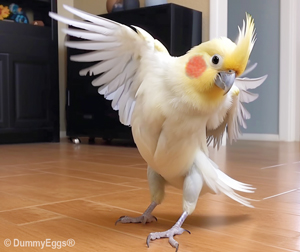
It's important to note that while these birds are known to be determinate egg layers, individual birds may have different egg-laying patterns depending on various factors such as age, health, diet, and living conditions. Once a female bird has laid the set number of eggs for the breeding season, she will typically stop laying and begin the process of incubating and raising the chicks that hatch from the eggs.
In species with determinate egg laying, the reproductive cycle is typically triggered by external factors such as changes in daylight or temperature. The female bird's body will produce a set number of eggs in response to these triggers, and once those eggs are laid, the breeding cycle for the season is considered complete.
For some species, determinate egg laying can be an advantage in terms of conserving energy and resources. By laying a set number of eggs, the female bird can ensure that each egg is well-developed and has a better chance of surviving to adulthood. In fact, breeders have been using dummy eggs for years to increase chick survival rates by replacing laid eggs with plastic and mechanically incubating the real ones.
However, there are also potential downsides to determinate egg laying, particularly in captivity. In situations where a female bird is not able to incubate and care for her eggs properly. If her eggs are removed, she will keep laying replacements until a full clutch is complete. This can be physically and emotionally taxing, leading to health problems such as eggbinding, calcium depletion, frustration, and stress behaviors such as feather plucking.
When a hen becomes broody, her body undergoes hormonal changes that trigger her instinct to incubate eggs. She will seek out a nest, often hiding in a secluded location, and will begin to lay eggs until she has a clutch of eggs that she feels is sufficient to begin incubation.
Using a bowl to hold your dummy eggs can have several benefits. Placing your dummy eggs in a bowl can help keep them stable and prevent them from rolling or shifting around in the nest. This is important because a broody hen may become agitated or abandon her nest if the eggs move around too much. Using a bowl to hold your dummy eggs can make it easier to move the eggs around or replace them as needed. This is especially true if you need to remove the eggs from the nest to clean them or add new eggs.
“Don't let unwanted egg laying disrupt your bird's health and happiness, order your plastic bird eggs from DummyEggs.com today and enjoy a stress-free solution for both you and your feathered friends.”
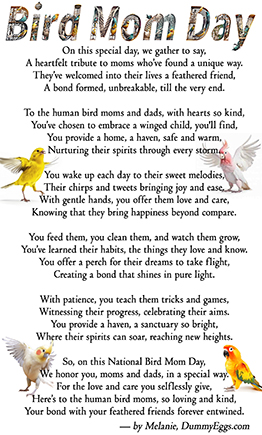
Celebrating National Human Bird Moms and Dads Day
May 15, 2023
On this special day, we gather to say,
A heartfelt tribute to moms who’ve found a unique way.
They’ve welcomed into their lives a feathered friend,
A bond formed, unbreakable, till the very end.
To the human bird moms and dads, with hearts so kind,
You’ve chosen to embrace a winged child, you'll find,
You provide a home, a haven, safe and warm,
Nurturing their spirits through every storm.
You wake up each day to their sweet melodies,
Their chirps and tweets bringing joy and ease.
With gentle hands, you offer them love and care,
Knowing that they bring happiness beyond compare.
You feed them, you clean them, and watch them grow,
You’ve learned their habits,
the things they love and know.
You offer a perch for their dreams to take flight,
Creating a bond that shines in pure light.
With patience, you teach them tricks and games,
Witnessing their progress, celebrating their aims.
You provide a haven, a sanctuary so bright,
Where their spirits can soar, reaching new heights.
So, on this National Bird Mom Day,
We honor you, moms and dads,
in a special way.
For the love and care you selflessly give,
Here’s to the human bird moms,
so loving and kind,
Your bond with your feathered friends forever entwined.
— by Melanie, DummyEggs.com
Copyright© Melanie Brandstein aka DummyEggs® 2024 All rights reserved. Lakeland Florida USA
All images and copy are protected by copyright. DummyEggs® is a registered trademark
DummyEggs® manufactures and sells plastic bird eggs to aid in reducing complications
from the natural and ongoing reproductive cycle of female birds.
We are not medical professionals or veterinarians. Please consult with your avian veterinarian for all health concerns as soon as possible.